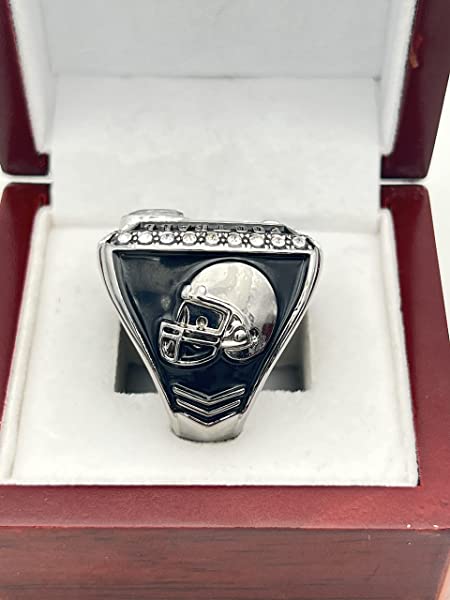College football championship rings are much more than brilliant pieces of metal and gemstones. They are powerful symbols of victory, teamwork, discipline, and the relentless pursuit of excellence that defines collegiate athletics. These rings tell stories of commitment, long seasons of grueling training, and the pride that comes from achieving greatness on the field. The success behind college football championship rings lies not only in their design and presentation but also in what they represent for players, coaches, and fans across the nation. Understanding their evolution, symbolism, and influence reveals why they hold such an enduring place in the culture of American sports.
The Deep History of College Football Championship Rings
The tradition of awarding championship rings began in the early 20th century, originally as a way to commemorate victories in professional sports. Over time, the practice extended to collegiate athletics, where football quickly became one of the most prominent recipients of this recognition. The first college football championship rings were modest in design, often simple bands engraved with the school’s name and the championship year. However, as college football grew into one of the most popular and profitable sports in the United States, the rings evolved into intricate works of art, celebrating both individual achievement and collective triumph.
By the mid-20th century, championship rings had become an essential part of college football tradition. Winning teams across major conferences celebrated their victories with ceremonies where rings were awarded to every player, coach, and staff member involved in the championship run. Today, these rings are designed to reflect the prestige of the program and the magnitude of the accomplishment, often incorporating the school’s colors, mascots, and championship logos in stunning detail.
Symbolism and Pride in Every Design
Every championship ring tells a story. Each element, whether it’s the choice of gemstones, the engraved year, or the team’s motto, represents something meaningful to the players and the institution. The ring is a wearable chronicle of the team’s journey, from preseason workouts to the final whistle of the title game.
For players, the ring symbolizes the culmination of years of hard work, sacrifice, and dedication. For coaches, it reflects the success of their leadership and strategy. And for the university, it stands as a lasting reminder of excellence and pride that enhances its athletic reputation. Beyond the aesthetics, these rings are a tangible reminder of what it means to be part of something bigger than oneself, a team united by the pursuit of victory.
The Design Evolution of Championship Rings
As college football programs have risen to prominence, the rings themselves have become increasingly sophisticated. Earlier designs were typically understated, featuring a single gemstone and simple engravings. Today’s rings are bold statements of identity, combining craftsmanship, artistry, and advanced manufacturing techniques.
Designers now integrate multiple layers, colors, and textures into a single piece. Team logos are often sculpted in raised relief or set in colored stones to stand out vividly. The sides of the ring frequently feature player numbers, conference logos, and even specific game scores, ensuring every detail of the championship run is memorialized. Modern technology also allows for precision engraving, enabling intricate patterns and symbols that were once impossible to achieve.
The Emotional Impact on Players and Programs
For athletes, receiving a championship ring is one of the most emotional moments of their careers. It represents not just a win but a legacy, a physical manifestation of their journey through adversity, teamwork, and triumph. The moment a player slides the ring onto their finger, they relive every challenge overcome along the way.
For many, it’s a dream come true, a keepsake that connects them to their teammates, coaches, and university for life. Years after their playing days are over, former athletes often speak of their championship rings as prized possessions, treasured as much for the memories they hold as for their material value. The emotional connection to these rings underscores why they remain such an integral part of college football tradition.
A Legacy of Teamwork and Determination
Behind every college football championship ring lies a story of teamwork. Championships are never won by a single individual; they are the result of countless hours of practice, preparation, and mutual trust among players and coaches. Each ring represents the collective effort of an entire team working toward a shared goal.
The discipline it takes to win a championship mirrors the determination and resilience required to succeed in life beyond the field. That’s why the symbolism of these rings extends far beyond sports; they embody values like perseverance, leadership, and unity that inspire athletes long after the final game has ended.
The Celebration of Achievement
Championship celebrations are among the most anticipated events in college athletics. After the final victory, universities often hold special ceremonies to honor their teams. These events bring together players, coaches, alumni, and fans to relive the glory of the season. The highlight of these celebrations is often the moment when the rings are presented.
The presentation ceremony is about more than recognition; it’s about gratitude. Coaches thank their players, players thank their teammates, and everyone acknowledges the shared sacrifice that led to the title. The unveiling of the rings, gleaming under bright lights, serves as a powerful reminder of how hard work and unity lead to success.
The Economic and Cultural Influence of College Football Rings
The prominence of college football championship rings has grown alongside the sport’s commercial success. Major bowl games and national championships attract millions of viewers and generate significant revenue for universities. As the stakes have risen, so too has the prestige of the rings awarded.
These rings have become cultural icons, featured in media coverage, displayed in athletic halls of fame, and even used in recruiting efforts to inspire future athletes. Programs proudly showcase their rings to demonstrate their legacy of success, motivating players to carry on the tradition. In this way, championship rings serve not only as personal mementos but also as powerful marketing tools that reinforce a program’s image of excellence.
Notable Examples of Iconic College Football Rings
Some of the most memorable championship rings come from powerhouse programs whose dominance on the field is matched by their flair for presentation. The University of Alabama, for example, is known for its striking designs featuring the iconic crimson “A” encrusted in jewels, symbolizing its storied history of success. Similarly, Clemson University’s championship rings are celebrated for their attention to detail, often highlighting key moments from their playoff victories and the team’s “All In” philosophy.
Each program puts its unique stamp on the design, ensuring that no two championship rings are alike. The result is a collection of artifacts that chronicle the rich and diverse history of college football’s greatest achievements.
The Enduring Value of a Championship Ring
While the materials used to make championship rings, gold, silver, and precious stones, certainly contribute to their value, their true worth lies in the meaning they carry. For the players, a championship ring is a constant reminder of what it took to reach the top. It embodies not just success, but also resilience, teamwork, and the unbreakable bonds formed through shared struggle.
For fans and supporters, these rings represent the glory of their beloved teams. They serve as timeless reminders of unforgettable seasons, legendary players, and moments that define the spirit of college football.
The Future of College Football Championship Rings
As technology and design innovation continue to advance, championship rings are becoming even more intricate and symbolic. Designers are experimenting with new materials, engraving methods, and gemstone settings to make each ring a masterpiece worthy of the achievement it represents. At the same time, the essence of what these rings symbolize remains unchanged: the honor of victory, the pride of teamwork, and the joy of being part of something truly extraordinary.
No matter how styles evolve, the emotional connection to championship rings will always endure. They will continue to inspire future generations of athletes to chase their dreams and uphold the legacy of excellence that defines college football.
A Tradition That Defines Greatness
College football championship rings are far more than trophies; they are emblems of achievement, unity, and pride. Each ring tells a story of sacrifice, perseverance, and triumph that resonates far beyond the gridiron. They capture the essence of college football’s spirit, the passion, the drive, and the unwavering commitment to greatness.
For players, they are lifelong reminders of what’s possible when you give everything for your team. For fans, they are symbols of shared glory and tradition. And for programs, they are testaments to the excellence that continues to shape the landscape of college sports.
Celebrate your love for the game and its timeless traditions with your own symbol of success. Find your perfect championship rings. Explore our collection of sports rings and choose from a variety of designs. Shop now at Discount Sports Rings.











